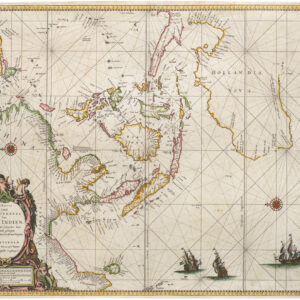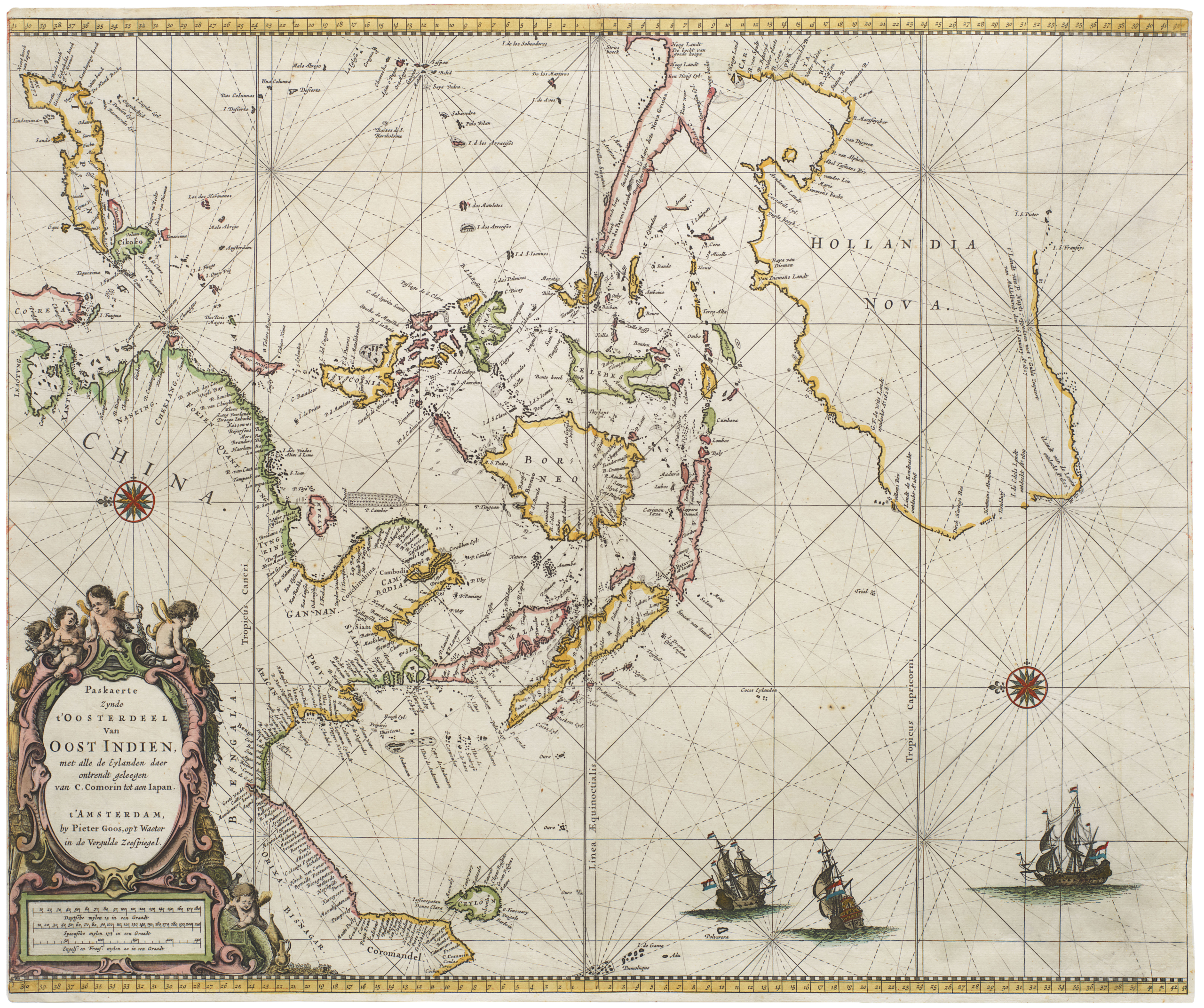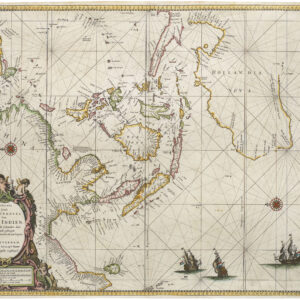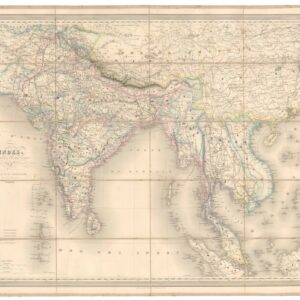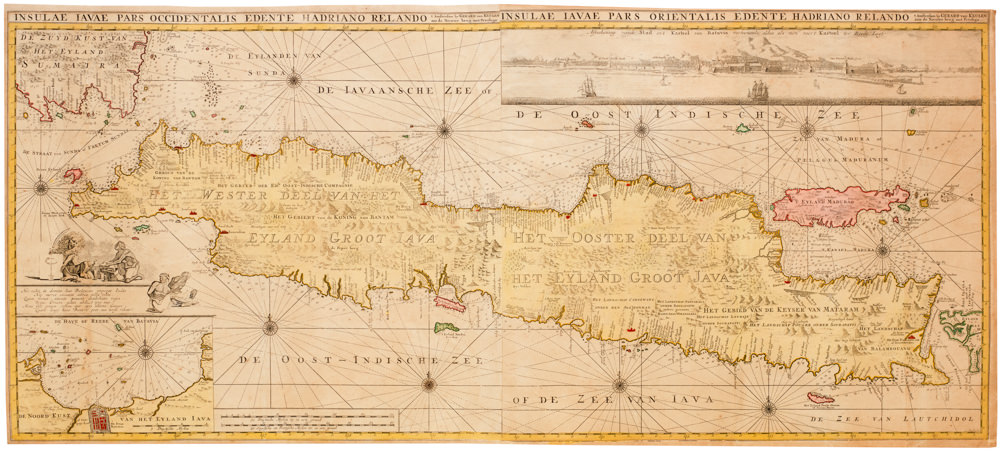1650 Merian map of Southeast Asia: a beautiful chart of one of the most important mercantile regions in the 17th century.
India Orientalis et Insulae Adiecentes.
$875
1 in stock
Description
This gorgeous example of Matthäus Merian’s map of Southeast Asia was not only based on Dutch antecedents like Willem Blaeu’s map of the region, but also on the most recent Dutch explorations and discoveries in the southwest Pacific. The map focuses on the Indonesian Archipelago and the Philippines, but covers an enormous area that includes the Indian Subcontinent, China, southern Japan and Korea, and the surprising appearance of a new continent in the lower part of the map. To the right we find an early rendition of the large island of Papua New Guinea. The island has been labeled as such, but its ephemeral outline reveals how little was known about it at this stage.
A more interesting inclusion is found extending from the bottom of the map. Labeled ‘G.F. de Witt’s Land’ and ‘T Land van D’ Eendracht,’ this constitutes one of the first printed depictions of the Australian coastline. Its inclusion was based on recent discoveries by the crew of the Vianen; a Dutch East India Company (VOC) merchantman, captained by Gerrit Frederikszoon de Witt, who in 1628 was blown severely off course by monsoon winds and ended up running aground near Barrow Island on the northern coast of Australia. During their return journey to Batavia, de Witt charted significant parts of the coastline and submitted his findings to the VOC on Java. The report also mentioned seeing local peoples on the beach; an encounter that may well be the first between Europeans and Indigenous Australians.
The original map was drawn up by Hessel Gerritz in 1628 and he labeled the new territory ‘G.F. de Witt’s Land.’ Within a few short years, varieties of this new landmass, often applying the same label, began appearing on Dutch maps, including this map by Swiss-German cartographer Matthäus Merian. It was not until the legendary voyages of Abel Tasman in 1642 and 1644 that a firmer concept of this new continent was achieved, and even longer before Tasman’s discoveries seeped into the cartographic record. Merian’s work on this map may well have coincided with Tasman’s iconic voyages, though he most likely would have been unaware of this coming ‘update.’
De Witt’s survey is not the only fresh Dutch discovery that has been embedded in this map. Dutch captain Dirk Hartog sailed on this region in 1615-16. He landed on what is today Dirk Hartog Island in Shark Bay and is credited as the first European to set foot on the Australian continent. Hartog explored parts of the coast to the north and Merian has clearly drawn on his surveys as well when compiling this version of Australia. This is seen in the labeling of the northern part of this continent as ’T Land van D’ Eendracht (Eendracht being the name of Hartog’s ship). The composition shows how 17th century cartographers sometimes struggled to merge different and often conflicting reports onto their maps.
The map is generally oriented towards the strong Amsterdam market, which can seen in the fact that it was published in Dutch, despite its German origin. The map is extremely detailed, with numerous place names and topographic details recorded throughout, reflecting just how comprehensive geographic knowledge of this region had become in the last half century. Despite its accuracy for the period, the relative proportions between the sea and the different landmasses remains completely off. Borneo, for example, is almost the same size as the entire Indian Subcontinent, and the generally disproportionate allocation of space to land rather than sea reveals that this was not a map meant for navigation. Rather, it was a way of visualizing an important but far-off region to interested parties back home. Even today, it is an evocative reminder of just how active the Dutch were in Southeast Asia during the 17th century.
In addition to the wonderful geography, Merian’s map includes several decorative elements, including a 16-point compass rose, Dutch sailing ships plowing the southern waters, and a substantial cartouche flanked by two gentlemen of Asian origin.
Cartographer(s):
Matthäus Merian (September 1593 – 19 June 1650) was a Swiss-born engraver who worked in Frankfurt for most of his career, where he also ran a publishing house. He was a member of the patrician Basel Merian family.
Early in his life, he had created detailed town plans in his own unique style, for example plans of both Basel and Paris (1615). With Martin Zeiler (1589 – 1661), a German geographer, and later (circa 1640) with his own son, Matthäus Merian produced a collection of topographic maps. The 21-volume set was collectively known as the Topographia Germaniae and included numerous town-plans and views, as well as maps of most countries and a world map. The work was so popular that it was re-issued in many editions. He also took over and completed the later parts and editions of the Grand Voyages and Petits Voyages, originally started by Theodor de Bry in 1590. Merian’s work inspired the Swedish royal cartographer, Erik Dahlberg, to produce his Suecia Antiqua et Hodierna, which became a cornerstone in European mapping.
After his death, his sons Matthäus Jr. and Caspar took over the publishing house. They continued publishing the Topographia Germaniae and the Theatrum Europaeum under the name ‘Merian Erben’ (i.e. Heirs of Merian). Today, the German travel magazine Merian is named after him.
Condition Description
Optimal.
References
